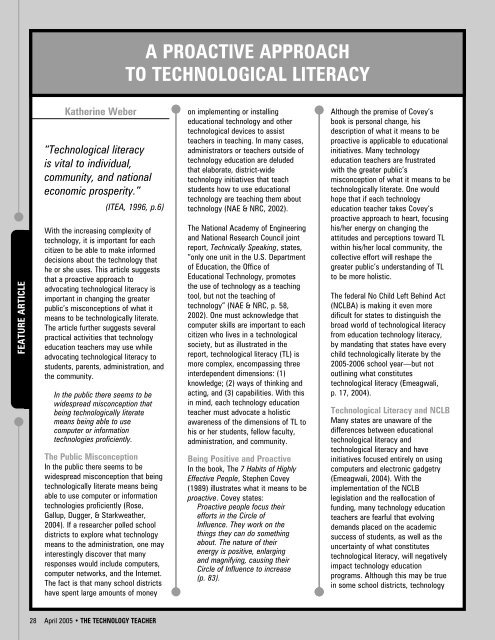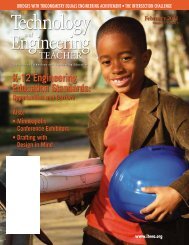Teaching Elements and Principles of Bridge Design - International ...
Teaching Elements and Principles of Bridge Design - International ...
Teaching Elements and Principles of Bridge Design - International ...
You also want an ePaper? Increase the reach of your titles
YUMPU automatically turns print PDFs into web optimized ePapers that Google loves.
A PROACTIVE APPROACH<br />
TO TECHNOLOGICAL LITERACY<br />
FEATURE ARTICLE<br />
Katherine Weber<br />
“Technological literacy<br />
is vital to individual,<br />
community, <strong>and</strong> national<br />
economic prosperity.”<br />
(ITEA, 1996, p.6)<br />
With the increasing complexity <strong>of</strong><br />
technology, it is important for each<br />
citizen to be able to make informed<br />
decisions about the technology that<br />
he or she uses. This article suggests<br />
that a proactive approach to<br />
advocating technological literacy is<br />
important in changing the greater<br />
public’s misconceptions <strong>of</strong> what it<br />
means to be technologically literate.<br />
The article further suggests several<br />
practical activities that technology<br />
education teachers may use while<br />
advocating technological literacy to<br />
students, parents, administration, <strong>and</strong><br />
the community.<br />
In the public there seems to be<br />
widespread misconception that<br />
being technologically literate<br />
means being able to use<br />
computer or information<br />
technologies pr<strong>of</strong>iciently.<br />
The Public Misconception<br />
In the public there seems to be<br />
widespread misconception that being<br />
technologically literate means being<br />
able to use computer or information<br />
technologies pr<strong>of</strong>iciently (Rose,<br />
Gallup, Dugger, & Starkweather,<br />
2004). If a researcher polled school<br />
districts to explore what technology<br />
means to the administration, one may<br />
interestingly discover that many<br />
responses would include computers,<br />
computer networks, <strong>and</strong> the Internet.<br />
The fact is that many school districts<br />
have spent large amounts <strong>of</strong> money<br />
on implementing or installing<br />
educational technology <strong>and</strong> other<br />
technological devices to assist<br />
teachers in teaching. In many cases,<br />
administrators or teachers outside <strong>of</strong><br />
technology education are deluded<br />
that elaborate, district-wide<br />
technology initiatives that teach<br />
students how to use educational<br />
technology are teaching them about<br />
technology (NAE & NRC, 2002).<br />
The National Academy <strong>of</strong> Engineering<br />
<strong>and</strong> National Research Council joint<br />
report, Technically Speaking, states,<br />
“only one unit in the U.S. Department<br />
<strong>of</strong> Education, the Office <strong>of</strong><br />
Educational Technology, promotes<br />
the use <strong>of</strong> technology as a teaching<br />
tool, but not the teaching <strong>of</strong><br />
technology” (NAE & NRC, p. 58,<br />
2002). One must acknowledge that<br />
computer skills are important to each<br />
citizen who lives in a technological<br />
society, but as illustrated in the<br />
report, technological literacy (TL) is<br />
more complex, encompassing three<br />
interdependent dimensions: (1)<br />
knowledge; (2) ways <strong>of</strong> thinking <strong>and</strong><br />
acting, <strong>and</strong> (3) capabilities. With this<br />
in mind, each technology education<br />
teacher must advocate a holistic<br />
awareness <strong>of</strong> the dimensions <strong>of</strong> TL to<br />
his or her students, fellow faculty,<br />
administration, <strong>and</strong> community.<br />
Being Positive <strong>and</strong> Proactive<br />
In the book, The 7 Habits <strong>of</strong> Highly<br />
Effective People, Stephen Covey<br />
(1989) illustrates what it means to be<br />
proactive. Covey states:<br />
Proactive people focus their<br />
efforts in the Circle <strong>of</strong><br />
Influence. They work on the<br />
things they can do something<br />
about. The nature <strong>of</strong> their<br />
energy is positive, enlarging<br />
<strong>and</strong> magnifying, causing their<br />
Circle <strong>of</strong> Influence to increase<br />
(p. 83).<br />
Although the premise <strong>of</strong> Covey’s<br />
book is personal change, his<br />
description <strong>of</strong> what it means to be<br />
proactive is applicable to educational<br />
initiatives. Many technology<br />
education teachers are frustrated<br />
with the greater public’s<br />
misconception <strong>of</strong> what it means to be<br />
technologically literate. One would<br />
hope that if each technology<br />
education teacher takes Covey’s<br />
proactive approach to heart, focusing<br />
his/her energy on changing the<br />
attitudes <strong>and</strong> perceptions toward TL<br />
within his/her local community, the<br />
collective effort will reshape the<br />
greater public’s underst<strong>and</strong>ing <strong>of</strong> TL<br />
to be more holistic.<br />
The federal No Child Left Behind Act<br />
(NCLBA) is making it even more<br />
dificult for states to distinguish the<br />
broad world <strong>of</strong> technological literacy<br />
from education technology literacy,<br />
by m<strong>and</strong>ating that states have every<br />
child technologically literate by the<br />
2005-2006 school year—but not<br />
outlining what constitutes<br />
technological literacy (Emeagwali,<br />
p. 17, 2004).<br />
Technological Literacy <strong>and</strong> NCLB<br />
Many states are unaware <strong>of</strong> the<br />
differences between educational<br />
technological literacy <strong>and</strong><br />
technological literacy <strong>and</strong> have<br />
initiatives focused entirely on using<br />
computers <strong>and</strong> electronic gadgetry<br />
(Emeagwali, 2004). With the<br />
implementation <strong>of</strong> the NCLB<br />
legislation <strong>and</strong> the reallocation <strong>of</strong><br />
funding, many technology education<br />
teachers are fearful that evolving<br />
dem<strong>and</strong>s placed on the academic<br />
success <strong>of</strong> students, as well as the<br />
uncertainty <strong>of</strong> what constitutes<br />
technological literacy, will negatively<br />
impact technology education<br />
programs. Although this may be true<br />
in some school districts, technology<br />
28 April 2005 • THE TECHNOLOGY TEACHER
















